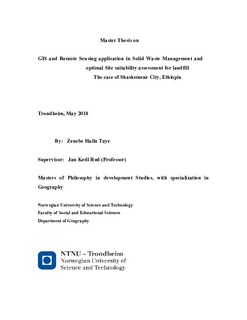GIS and remote sensing application in solid waste management and optimal site suitability assessment for landfill : the case of Shashemene City, Ethiopia
Abstract
Now a day, many cities and towns are growing rapidly in Ethiopia. Among the fast growing towns and cities, Shashemene is probably the prominent one. This is due to its strategic position located along the ancient long distance trade routes. The city is expanding rapidly with increasing number of industries and service sectors such as hotels, restaurants, small and micro enterprises. As town grows, so does the amount of waste production specially the solid hazard waste. It is inevitable that waste production and management problems increases with rapid urban growth resulting in pressure on sanitary related problems in the city. Because of Improper waste management practices and limited public and community trucks and containers, people are being forced to dispose their wastes in any open fields. Poor sanitary situation has become a common characteristics of many villages in the city. This necessitates the applications of Geo-information systems on landfill site suitability assessment as a solution to address the problem and effectively manage the wastes in the city. Although the city has already one solid waste disposal site located in South Western part of the city, it not been scientifically chosen and no technological applications have been made in selection of the disposal site.
Factor maps such as Land use, slope, road map, social service maps, water well and stream data have been used on this thesis. Once all necessary arrangements are made, Geodatabase have been created to hold all feature classes and raster data during the analysis process. Different Geoprocessing tools and spatial analysis operation were carried out in a model builder created for this particular thesis. All factor maps having constraint are made restricted and the rest are given a suitability scale from the highest four to the lowest one suitability scale. The weights, which have been applied against each factor maps, were based on reviewing literatures, personal experiences and judgement and consultation of experts in the area. Finally, a weighted overlay tool from spatial analysis tools have been used and factor maps are inserted in accordance of their weighing. As a result, highly suitable areas for a landfill development cover very small area in southeastern, northeastern and southwestern borders of the city, constituting approximately 1.1% of the total area of the city while unsuitable areas cover the central and wider area of the city of Shashemene, constituting approximately half of the city’s areal coverage. Most parts of South central and northern parts of the city where there exist built up and services facilities are shown as unsuitable for a landfill site development.
